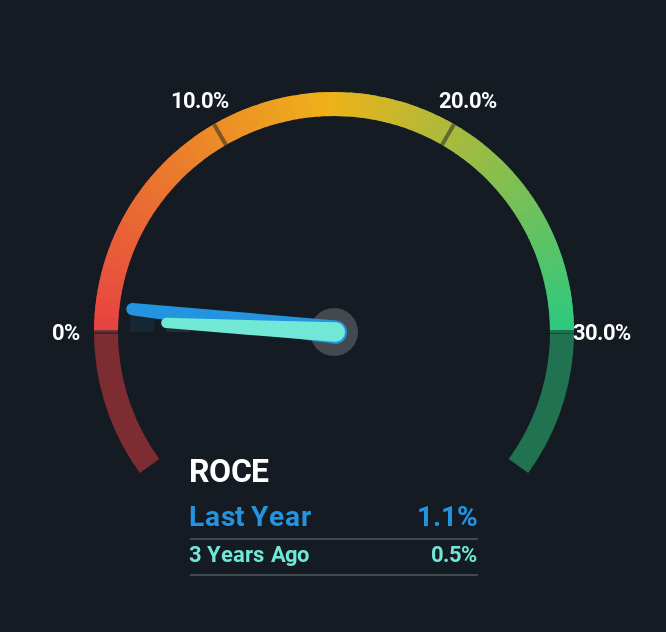- Israel
- /
- Medical Equipment
- /
- TASE:NISA
These Return Metrics Don't Make Nissan Medical Industries (TLV:NISA) Look Too Strong
If you're looking at a mature business that's past the growth phase, what are some of the underlying trends that pop up? Typically, we'll see the trend of both return on capital employed (ROCE) declining and this usually coincides with a decreasing amount of capital employed. Basically the company is earning less on its investments and it is also reducing its total assets. So after glancing at the trends within Nissan Medical Industries (TLV:NISA), we weren't too hopeful.
Return On Capital Employed (ROCE): What Is It?
Just to clarify if you're unsure, ROCE is a metric for evaluating how much pre-tax income (in percentage terms) a company earns on the capital invested in its business. Analysts use this formula to calculate it for Nissan Medical Industries:
Return on Capital Employed = Earnings Before Interest and Tax (EBIT) ÷ (Total Assets - Current Liabilities)
0.011 = ₪4.4m ÷ (₪658m - ₪250m) (Based on the trailing twelve months to June 2025).
Thus, Nissan Medical Industries has an ROCE of 1.1%. In absolute terms, that's a low return and it also under-performs the Medical Equipment industry average of 7.8%.
See our latest analysis for Nissan Medical Industries

While the past is not representative of the future, it can be helpful to know how a company has performed historically, which is why we have this chart above. If you'd like to look at how Nissan Medical Industries has performed in the past in other metrics, you can view this free graph of Nissan Medical Industries' past earnings, revenue and cash flow.
What Can We Tell From Nissan Medical Industries' ROCE Trend?
In terms of Nissan Medical Industries' historical ROCE trend, it isn't fantastic. Unfortunately, returns have declined substantially over the last five years to the 1.1% we see today. On top of that, the business is utilizing 20% less capital within its operations. When you see both ROCE and capital employed diminishing, it can often be a sign of a mature and shrinking business that might be in structural decline. Typically businesses that exhibit these characteristics aren't the ones that tend to multiply over the long term, because statistically speaking, they've already gone through the growth phase of their life cycle.
The Bottom Line On Nissan Medical Industries' ROCE
To see Nissan Medical Industries reducing the capital employed in the business in tandem with diminishing returns, is concerning. Long term shareholders who've owned the stock over the last five years have experienced a 64% depreciation in their investment, so it appears the market might not like these trends either. With underlying trends that aren't great in these areas, we'd consider looking elsewhere.
If you want to know some of the risks facing Nissan Medical Industries we've found 4 warning signs (3 don't sit too well with us!) that you should be aware of before investing here.
While Nissan Medical Industries isn't earning the highest return, check out this free list of companies that are earning high returns on equity with solid balance sheets.
Valuation is complex, but we're here to simplify it.
Discover if Nissan Medical Industries might be undervalued or overvalued with our detailed analysis, featuring fair value estimates, potential risks, dividends, insider trades, and its financial condition.
Access Free AnalysisHave feedback on this article? Concerned about the content? Get in touch with us directly. Alternatively, email editorial-team (at) simplywallst.com.
This article by Simply Wall St is general in nature. We provide commentary based on historical data and analyst forecasts only using an unbiased methodology and our articles are not intended to be financial advice. It does not constitute a recommendation to buy or sell any stock, and does not take account of your objectives, or your financial situation. We aim to bring you long-term focused analysis driven by fundamental data. Note that our analysis may not factor in the latest price-sensitive company announcements or qualitative material. Simply Wall St has no position in any stocks mentioned.
About TASE:NISA
Nissan Medical Industries
Through its subsidiary, engages in the manufacturing and marketing of spunlace non-woven fabrics in the United States, Canada, Europe, and Israel.
Adequate balance sheet with slight risk.
Market Insights
Community Narratives




